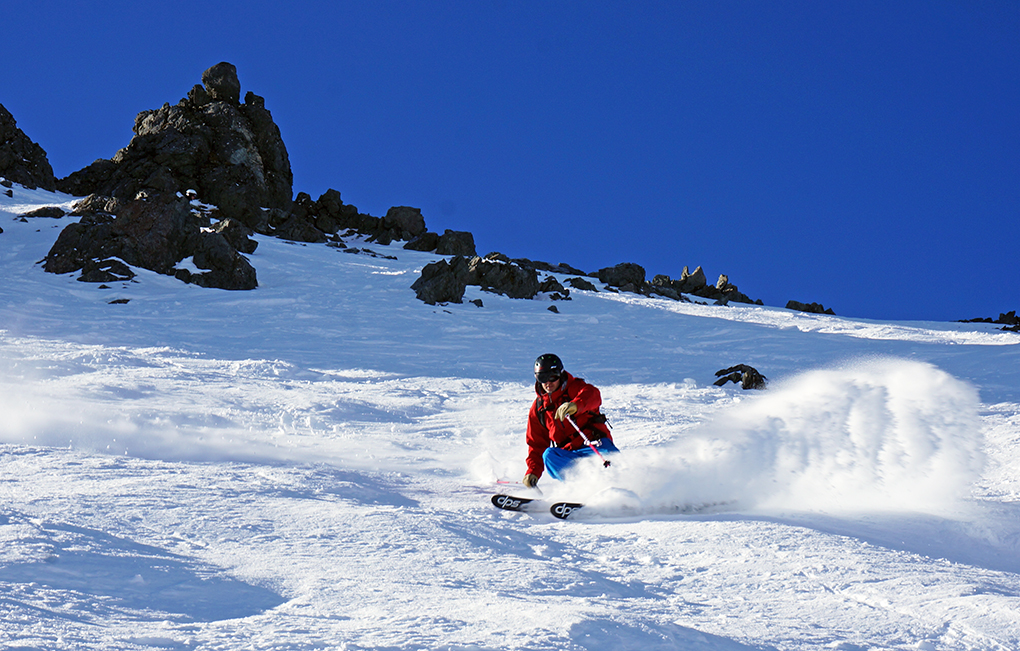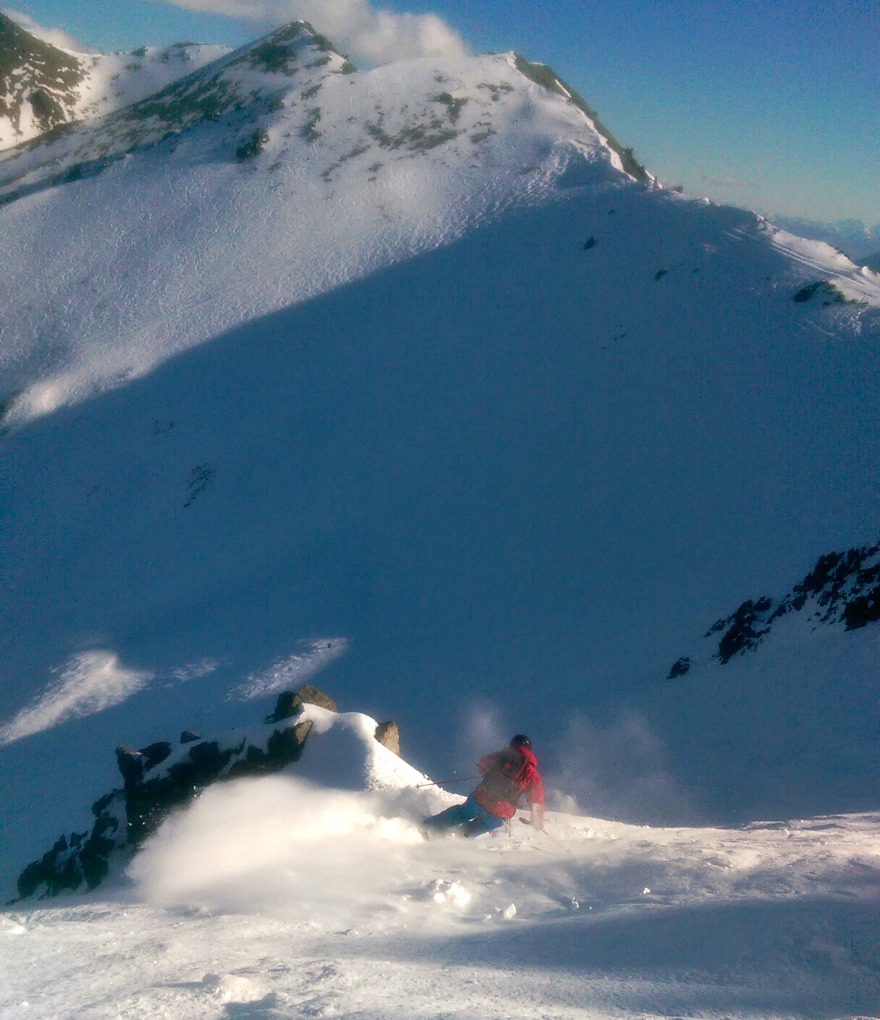
Ski: 2016-2017 DPS Wailer 105 Hybrid T2, 185cm
Available Lengths: 178, 185 cm
Actual Tip-to-Tail Length (straight tape pull): 183.6cm
Stated Weight per Ski: 2,340 grams
Blister’s Measured Weight per Ski: 2,297 & 2,267 grams
Stated Dimensions (mm): 136-105-119
Sidecut Radius: 26-29 meters
Core Construction: Poplar + Titanal (2-Layer) + Fiberglass Laminate
Tip & Tail Splay (ski decambered): 63 / 16 mm
Traditional Camber Underfoot: ~2 mm
Boots / Bindings (DIN setting): Tecnica Cochise Pro 130 / Marker Jester (DIN at 11)
Mount Location: Factory Recommended
Test Location: Broken River Ski Area
Days Skied: 4
[Editor’s Note: Our review was conducted on the 14/15 Wailer, which was not changed for 15/16 or 16/17, except for the graphics.]
Paul Forward has written a very good review of the new DPS Wailer 105, and you should check it out.
Paul and I have been passing the Wailer 105 back and forth this trip, and we did so again yesterday at Broken River Ski Area. We are in large agreement about this ski, so my aim here is to try to fill out the picture a bit, offer a few more comparisons between the Wailer 105 and other skis in its class, and say a bit more about who this ski is probably best suited for.
Variable Conditions Charger
Like Paul, I am psyched to see DPS using titanal, and I think this is a great move for the company. This Wailer 105 offers a very different ride than anything DPS has ever offered.
When DPS first came out with the Wailer 112RPC, some of us were assuming / hoping that it would feel more like the damp, directional, variable conditions chargers we were familiar with (and loved) from other companies. But as I wrote in my review of the Wailer 112RPC that ski still excels in soft snow and consistent conditions—deep snow, wind buff, groomers, etc.
The new DPS Wailer 105 excels in variable conditions.
On-Snow Feel
If you really love the super light, quick feel of the DPS Wailer 99, Wailer 112, or Wailer 112RPC in variable conditions, then I seriously doubt that you will be thrilled with the Wailer 105 Hybrid T2. The difference is pretty night and day.
The 185cm Wailer 105 requires more energy to throw around than the 186cm Moment Belafonte, the 185cm Blizzard Cochise, or the 186cm Line Supernatural 108. The amount of work isn’t night and day, but it is definitely noticeable.

Groomers
On soft, spring groomers at Taos this past March, the Wailer 105’s were extremely smooth, and they felt (on groomers) as damp and stable as any ski I’ve been on in recent memory. The Wailer 105s have very little camber underfoot and don’t provide enormous rebound out of the turn, but they produce a plush ride at high speeds.
Steep Lines & Moguls
We’ve been skiing a chute at Broken River that reminds me a lot of Taos’ Zdarsky—it opens with steep, big, firm bumps at the top, then settles down into smoother, chalky snow about halfway through the chute, allowing you to open things up to make big, fast turns. It’s been my favorite line to ski at Broken River on the Wailer 105s.
If you’re not a physically strong skier, there will be better skis on the market for you. The Wailer 105 is going to be best suited for those who like the stability-at-speed of stiffer, heavier skis, and don’t mind the tradeoff of having to work a bit harder in tighter spots and bumps, and at slower speeds.
But when making repeated airplane turns on top of steep bumps, I loved how stable and sure the 105s are upon landing. You can land heavy on the shovels of the 105 and be supported, or land a bit on the tails and be supported.
Furthermore, given the impressive stability of the Wailer 105s, these are not beasts to turn. Compared to a 187cm, unrockered Dynastar XXL, the Wailer 105 is much easier to turn in soft chop and deeper snow, yet the 105s retain a good bit of the solid feel of the XXL underfoot.
Pow
You will be just fine skiing the 105s in 12” of fresh pow, but skis like this become more fun as the resort gets tracked out and that pow turns more and more firm. So if you are only skiing delightful, untracked pow, you might go with the DPS Wailer 99 Pure, or the DPS Wailer 112RP. But for those of us who want a ski that excels in demanding conditions rather than perfect conditions, the Wailer 105 is likely the better tool.
Further Comparisons:
DPS Wailer 105 vs. 14/15 Moment Belafonte, 186cm
The Wailer 105 is more damp and demanding than the new Belafonte. The Belafonte is certainly the more playful ski, and it also has a looser tail. But the tail of the Wailer 105 is still easy to feather. The Belafonte is lighter, and it feels lighter on snow.
For nuking down big faces in soft / even slightly soft conditions, I would give the edge to the Wailer 105. For skiing tight trees or big, tightly-spaced moguls, the Belafonte is a bit quicker and a bit less work. But again, on the feet of a physically strong skier, the Wailer 105s will turn.

DPS Wailer 105 vs. Salomon Q Lab, 190cm
The Wailer 105 is definitely more stable, more damp, and more demanding than the 183cm Salomon Q Lab. It feels heavier and stiffer. Then again, the Q Lab 183 isn’t heavy or very stiff. It feels nice. But these two skis really aren’t in the same category. As for the 190cm Salomon Q Lab…
The 190cm Salomon Q Lab’s tails are about the same stiffness as the Wailer 105’s, and these are two of the stiffest tails we’ve reviewed. And their tip shapes are similar, too. The Q Lab has far more camber underfoot—the Wailer 105 has just 1-2mms, the 190cm Q Lab is more like 5-6mms. On groomers, the edgehold of the Q Lab is tenacious, the camber underfoot provides plenty of pop out of the turn, and its shovels are easy to bend.
In fact, the shovels of the 190cm Q Lab are noticeably softer than the Wailer 105’s. I’ve argued that in variable conditions, those shovels feel a bit too soft. In even slightly soft variable conditions, the Wailer 105’s shovels feel quite dialed. It’s only in very firm, frozen, roughed-up off-piste terrain where the shovels of the Wailer 105 feel rather harsh.

Looking forward to seeing how the Armada Invictus fits into this category?!
Comparisons to the old 185 Cochise? Not quite sure how much softer the new Cochise feels relative to the old. Thanks
I can echo Paul and Jonathan’s observations about the new Wailer 105. I only spent a day or so on them last Spring, and they are a serious departure for DPS’s recent designs…nearly returning to the direction of the original Wailer 105. After skiing a bunch of DPS Hybrid and Carbon models, jumping on the T2 Wailer 105 is like clamping yourself into a damp and metallic set of sleds with stable crud-cutting ability and a sold, reliable feel underfoot. Not “playful”, but more a more “business-like” and rock-solid personality. I tend to be on the heavier side of many skiers at 185-190 lbs, and the strength of the Wailer 105 T2 was impressive, never folding or deviating, no matter what the pressure situation was. The new Wailer seems to like to get up to speed to show off its torsional traits and will make plenty of stronger and heavier skiers (or those who like the damp feel of metal) really happy when conditions get variable. I got the distinct impression the new Wailer 105 would have a long lifespan with its dense and solid construction. It’s good to see DPS exploring new directions for new styles of feel underfoot. The new Wailer 105 and Cassiar 95/85 models will give plenty of people something to try this season. (I was very impressed with the new Cassiar 85 and 95 as well last Spring)…Thanks to Jonathan and Paul for the observations….